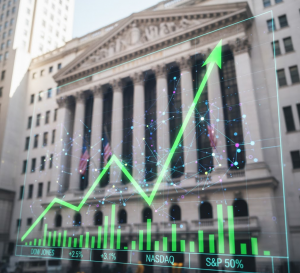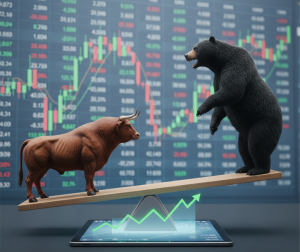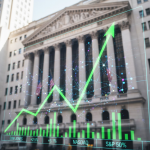Closing Bell: September 24, 2025
Summary (TL;DR)
For investors, the key takeaway from today’s trading is that the Federal Reserve’s cautious stance on future interest rate cuts is beginning to temper the market’s recent exuberance. Despite ongoing positive news in the technology sector, particularly around artificial intelligence, the broader market took a step back as investors recalibrated their expectations for how soon and how quickly the central bank will move to lower borrowing costs. This development is significant because it suggests a potential shift in the market’s primary driver, from pure tech-fueled optimism to a more nuanced assessment of macroeconomic policy and its impact on the economy.
What Happened?
The major U.S. stock indices finished the day in negative territory, pulling back from recent record highs. The Dow Jones Industrial Average, S&P 500, and the tech-heavy Nasdaq Composite all registered modest losses. The dominant theme of the day was a more cautious tone from Federal Reserve Chair Jerome Powell regarding the path of future interest rate cuts. His remarks suggested that while the central bank is prepared to act to support the economy, it will do so with a careful eye on inflation, which has remained stubbornly above the Fed’s target.
This overshadowed some positive corporate news, including strong earnings from Micron and continued significant investment announcements in the AI space from companies like Alibaba. While the energy and defense sectors saw some gains due to ongoing geopolitical tensions, the broader market sentiment was one of risk aversion.
Why It Matters?
Coming into the week, investors had been largely optimistic, buoyed by a seemingly unstoppable rally in technology stocks and the prospect of the Federal Reserve continuing to cut interest rates to stimulate a slowing economy. The expectation of lower borrowing costs has been a significant tailwind for the market, making it cheaper for companies to invest and expand.
Today’s comments from Chair Powell, however, introduced a note of uncertainty into this narrative. By signaling a “cautious approach,” the Fed is reminding investors that the fight against inflation is not over. This matters because if the Fed is less aggressive with rate cuts than previously anticipated, it could mean that borrowing costs will remain higher for longer, potentially dampening economic growth and corporate profits. The market’s reaction today indicates that investors are now weighing the powerful long-term growth story of technologies like AI against the more immediate headwind of a less accommodative central bank.
The Debate (The Bull vs. Bear Case)

The Bull Case (The Optimistic View): On one hand, optimists believe that the underlying fundamentals of the market remain strong. Analysts at BMO Capital Markets, for instance, have recently reiterated their belief that the secular bull market is still intact, with the powerful trend of AI adoption and strong corporate earnings providing a solid foundation for further gains. Proponents of this view point to the upward revision of global growth forecasts by the Organization for Economic Co-operation and Development (OECD) as evidence of economic resilience. They also highlight the significant investments being poured into AI infrastructure, such as Alibaba’s increased budget, as a long-term catalyst for growth that can weather short-term shifts in monetary policy.

The Bear Case (The Cautious View):
On the other hand, cautious voices point to the growing disconnect between market valuations and the economic realities. A primary concern, as highlighted by commentary from J.P. Morgan Research, is the potential for tariffs to eventually translate into higher consumer prices and squeezed corporate profit margins. Fed Chair Powell’s own description of equity prices as “fairly highly valued” adds weight to this concern. The bear case argues that the market has become overly dependent on the prospect of Federal Reserve rate cuts and that any deviation from these expectations could trigger a significant pullback. Furthermore, ongoing geopolitical tensions and a slowing labor market are seen as additional risks that could derail the market’s upward trajectory.
By the Numbers (Key Data & Metrics)
- Dow Jones Industrial Average: Closed at approximately 46,292.78, down about 88.76 points (-0.19%).
- S&P 500: Finished at roughly 6,656.92, a decrease of around 36.83 points (-0.55%).
- Nasdaq Composite: Ended the day near 22,573.47, shedding approximately 215.50 points (-0.95%).
- 10-Year Treasury Yield: Stood at about 4.12%, indicating investor demand for safer assets. (The yield on a bond moves inversely to its price; a lower yield suggests higher demand).
- WTI Crude Oil: Rose to approximately $64.30 a barrel, reflecting ongoing geopolitical tensions.
- Freeport-McMoRan (FCX): The mining giant’s stock fell significantly after announcing it expects lower copper and gold sales in the third quarter than previously anticipated.
- Micron Technology (MU): Reported better-than-expected quarterly earnings and a positive outlook, driven by strong demand for its memory chips used in AI applications.
Disclaimer: This article is for informational purposes only and does not constitute financial, investment, or legal advice. The information provided is a synthesis of publicly available data and expert analysis and should not be considered a recommendation to buy or sell any security. Investing in the stock market involves risk, including the possible loss of principal. Past performance is not indicative of future results. Readers should consult with a qualified financial advisor to determine an investment strategy that is suitable for their own personal financial situation and risk tolerance.


















